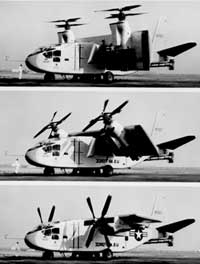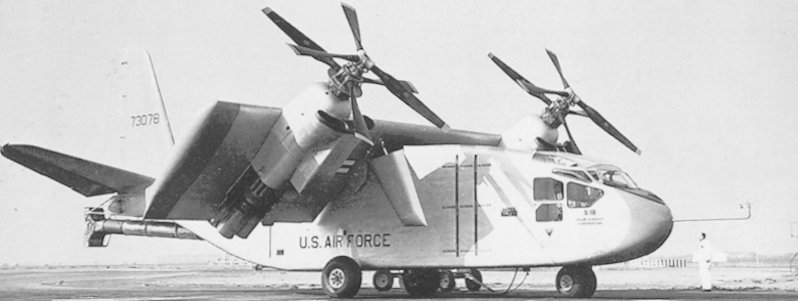|
Tiltwing
A tiltwing aircraft features a wing that is horizontal for conventional forward flight and rotates up for vertical takeoff and landing. It is similar to the tiltrotor design where only the propeller and engine rotate. Tiltwing aircraft are typically fully capable of VTOL operations.Markman, Steve and Bill Holder. "Tilt-Wing VTOL Systems". ''Straight Up: A History of Vertical Flight''. Schiffer Publishing, 2000. . The tiltwing design offers certain advantages in vertical flight relative to a tiltrotor. Because the slipstream from the rotor strikes the wing on its smallest dimension, the tiltwing is able to apply more of its engine power to lifting the aircraft. For comparison, the V-22 Osprey tiltrotor loses about 10% of its thrust to interference from the wings. Another advantage of tiltwing aircraft is the ease of transition between VTOL and horizontal flight modes. A tiltrotor must first fly forwards like a helicopter, building airspeed until wing lift is sufficient to allo ... [...More Info...] [...Related Items...] OR: [Wikipedia] [Google] [Baidu] |
Kaman K-16B
The Kaman K-16B is an experimental VTOL, vertical-takeoff-and-landing aircraft that was constructed by Kaman Aircraft for the United States Navy in 1959 to evaluate the tiltwing concept. Converted from a Grumman Goose amphibian, the K-16B underwent extensive wind tunnel and Tethered flight test, tethered testing, but was not flown before the project was terminated in 1962. Design and development During the late 1950s, there was extensive interest in the VTOL, vertical takeoff and landing concept for aircraft, with multiple experimental types ordered to develop the technology for potential service. The United States Navy contracted with Kaman Aircraft of Bloomfield, Connecticut, to build a testbed based on the company's 'rotorprop' concept for tiltwing aircraft,Swanborough 1964, p.50. using a Grumman G-21 Goose, Grumman JRF-5 Goose amphibious aircraft, amphibian and other existing parts to reduce the cost and time necessary.''Jane's'' 1959–1960, p.331. The fuselage and tail of th ... [...More Info...] [...Related Items...] OR: [Wikipedia] [Google] [Baidu] |
Hiller X-18
The Hiller X-18 was an experimental cargo transport aircraft designed to be the first testbed for tiltwing and V/STOL (vertical/short takeoff and landing) technology. Development Design work started in 1955 by Stanley Hiller Jr and Hiller Aircraft Corporation received a manufacturing contract and funding from the United States Air Force to build the only X-18 built, serialized ''57-3078''. To speed up construction and conserve money, the plane was constructed from scavenged parts including a Chase YC-122C Avitruc fuselage, ''49-2883'', and turboprops from the Lockheed XFV-1 and Convair XFY-1 Pogo experimental fighter programs. The tri-bladed contra-rotating propellers were a giant 16 ft (4.8 m) across. The Westinghouse turbojet engine had its exhaust diverted upwards and downwards at the tail to give the plane pitch control at low speeds. Hiller nicknamed their X-18 the Propelloplane for public relations purposes. Service history Preliminary testing occurred at ... [...More Info...] [...Related Items...] OR: [Wikipedia] [Google] [Baidu] |
Tiltrotor
A tiltrotor is an aircraft that generates lift (force), lift and thrust, propulsion by way of one or more powered Helicopter rotor, rotors (sometimes called ''proprotors'') mounted on rotating shaft (mechanical engineering), shafts or nacelles usually at the ends of a fixed wing. Almost all tiltrotors use a transverse rotor design, with a few exceptions that use other multirotor layouts. Tiltrotor design combines the VTOL capability of a helicopter with the speed and range (aircraft), range of a conventional fixed-wing aircraft. For vertical flight, the rotors are angled so the plane of rotation is horizontal, generating lift the way a normal helicopter rotor does. As the aircraft gains speed, the rotors are progressively tilted forward, with the plane of rotation eventually becoming vertical. In this mode the rotors provide thrust as a propeller (aircraft), propeller, and the airfoil of the fixed wings takes over providing the lift via the forward motion of the entire aircra ... [...More Info...] [...Related Items...] OR: [Wikipedia] [Google] [Baidu] |
Canadair CL-84 Dynavert
The Canadair CL-84 "Dynavert", designated by the Canadian Forces as the CX-131, was a V/STOL turbine tiltwing monoplane designed and manufactured by Canadair between 1964 and 1972. Only four of these experimental aircraft were built, with three entering flight testing. Two of the CL-84s crashed due to mechanical failures, with no fatalities in either accident. Despite the CL-84 being successful in the experimental and operational trials carried out between 1972 and 1974, none of the prospective customers placed any orders for the type. Development Between 1957 and 1963, Canadair carried out research in VTOL (vertical takeoff and landing) technology with the assistance of the National Research Board (NRB) and the Defense Research Board (DRB) of Canada. The studies pointed the way to a unique tilt-wing design. The wing and the powerplants of the aircraft could be tilted hydro-mechanically (recirculating ball actuator) so that the wing incidence changed through 100 degrees from a n ... [...More Info...] [...Related Items...] OR: [Wikipedia] [Google] [Baidu] |
NASA GL-10 Greased Lightning
The GL-10 Greased Lightning is a hybrid diesel-electric tiltwing unmanned aircraft. Development The wing has eight electric motor-driven propellers, while the horizontal stabilizer has two. In the future full-scale version, power will be generated by two 6 kW (8 hp) diesel engines which will charge lithium-ion batteries. The propellers on the leading edge of the wing provide high speed flow, and thus lift, on the wing even in low forward velocity flight allowing pitch, roll, and yaw control authority during the critical transition phase from hover to forward flight. The VTOL capability of this new class of UAV eliminates the requirement for additional ground support equipment like launch catapults and landing catch mechanisms. In addition, the propellers are designed for a relatively low tip speed resulting in a marked reduction in noise. The aircraft is designed to complete several vertical take-off and landings during its mission with a loiter endurance of 24 hours ... [...More Info...] [...Related Items...] OR: [Wikipedia] [Google] [Baidu] |
VTOL
A vertical take-off and landing (VTOL) aircraft is one that can takeoff and landing, take off and land vertically without relying on a runway. This classification can include a variety of types of aircraft including helicopters as well as thrust-vectoring fixed-wing aircraft and other hybrid aircraft with powered helicopter rotor, rotors such as cyclogyro, cyclogyros/cyclocopters and gyrodynes. Some VTOL aircraft can operate in other modes as well, such as CTOL (conventional take-off & landing), STOL (short take-off & landing), or STOVL (short take-off & vertical landing). Others, such as some helicopters, can only operate as VTOL, due to the aircraft lacking landing gear that can handle taxiing. VTOL is a subset of V/STOL (vertical or short take-off & landing). Some aerostat, lighter-than-air aircraft also qualify as VTOL aircraft, as they can hover, takeoff and land with vertical approach/departure profiles. Electric vertical takeoff and landing aircraft, or eVTOLs, are being ... [...More Info...] [...Related Items...] OR: [Wikipedia] [Google] [Baidu] |
VTOL DiscLoad-LiftEfficiency
A vertical take-off and landing (VTOL) aircraft is one that can take off and land vertically without relying on a runway. This classification can include a variety of types of aircraft including helicopters as well as thrust-vectoring fixed-wing aircraft and other hybrid aircraft with powered rotors such as cyclogyros/cyclocopters and gyrodynes. Some VTOL aircraft can operate in other modes as well, such as CTOL (conventional take-off & landing), STOL (short take-off & landing), or STOVL (short take-off & vertical landing). Others, such as some helicopters, can only operate as VTOL, due to the aircraft lacking landing gear that can handle taxiing. VTOL is a subset of V/STOL (vertical or short take-off & landing). Some lighter-than-air aircraft also qualify as VTOL aircraft, as they can hover, takeoff and land with vertical approach/departure profiles. Electric vertical takeoff and landing aircraft, or eVTOLs, are being developed along with more autonomous flight control tech ... [...More Info...] [...Related Items...] OR: [Wikipedia] [Google] [Baidu] |
V-22 Osprey
The Bell Boeing V-22 Osprey is an American multi-use, tiltrotor military transport aircraft, military transport and cargo aircraft with both vertical takeoff and landing (VTOL) and short takeoff and landing (STOL) capabilities. It is designed to combine the functionality of a conventional helicopter with the long-range, high-speed Cruise (aeronautics), cruise performance of a turboprop aircraft. The V-22 is operated by the United States and Japan, and is not only a new aircraft design, but a new type of aircraft that entered service in the 2000s, a tiltrotor compared to fixed wing and helicopter designs. The V-22 first flew in 1989 and after a long development was fielded in 2007. The design combines the vertical takeoff ability of a helicopter with the speed and range of a fixed-wing airplane. The failure of Operation Eagle Claw in 1980 during the Iran hostage crisis underscored that there were military roles for which neither conventional helicopters nor fixed-wing transport ... [...More Info...] [...Related Items...] OR: [Wikipedia] [Google] [Baidu] |
Vertol VZ-2
The Vertol VZ-2 (or Model 76) is a research aircraft built in the United States in 1957 to investigate the tiltwing approach to vertical take-off and landing. Design and development The aircraft had a fuselage of tubular framework (originally uncovered) and accommodation for its pilot in a helicopter-like bubble canopy. The T-tail incorporated small ducted fans to act as thrusters for greater control at low speeds. Ground tests began in April 1957 and on 13 August, the VZ-2 took off for the first time in hover mode only. On 23 July 1958, the aircraft made its first full transition from vertical flight to horizontal flight. By the time the test program ended in 1965, the VZ-2 had made some 450 flights, including 34 full transitions. The aircraft has been preserved by the National Air and Space Museum The National Air and Space Museum (NASM) of the Smithsonian Institution is a museum in Washington, D.C., in the United States, dedicated to history of aviation, human flight and ... [...More Info...] [...Related Items...] OR: [Wikipedia] [Google] [Baidu] |
LTV XC-142
The Ling-Temco-Vought (LTV) XC-142 is a tiltwing experimental aircraft designed to investigate the operational suitability of vertical/short takeoff and landing (V/STOL) transports. An XC-142A first flew conventionally on 29 September 1964, and completed its first transitional flight on 11 January 1965 by taking off vertically, changing to forward flight, and finally landing vertically. Its service sponsors pulled out of the program one by one, and it eventually ended due to a lack of interest after demonstrating its capabilities successfully. Development In 1959 the United States Army, Navy and Air Force began work on the development of a prototype V/STOL aircraft that could augment helicopters in transport-type missions. Specifically they were interested in designs with longer range and higher speeds than existing helicopters, in order to support operations over longer distances, or in the case of the United States Marine Corps, from further offshore. On 27 January 1961, a ... [...More Info...] [...Related Items...] OR: [Wikipedia] [Google] [Baidu] |
Airbus A³ Vahana
The Airbus Vahana (Sanskrit: ''Vāhana'', or Vahanam literally means "vehicle") was an electric-powered eight-propeller VTOL personal air vehicle prototype, or eVTOL, financed by A³ (pronounced "A-cubed"), by Airbus and Airbus Urban Mobility. The Vahana project started in 2016 as one of the first projects at A³, the advanced projects and partnerships outpost of Airbus Group in Silicon Valley. Airbus "envision Vahana being used by everyday commuters as a cost-comparable replacement for short-range urban transportation like cars or trains". It was planned to be a part of urban air mobility. The project was finished in December 2019. Development The convertiplane aircraft design, funded by the European aircraft manufacturer Airbus, called Vahana (Sanskrit: "vehicle"), started in 2016. It was being developed at A³ (A-cubed), the expanded project and partnership outpost of Airbus in Silicon Valley. Airbus said "Our work on this demonstrator confirms our belief that fully au ... [...More Info...] [...Related Items...] OR: [Wikipedia] [Google] [Baidu] |







